During his nearly six decades as a pharmacist, Carl F. Hanneman got to know a lot of people. He forged good relationships with the many sales reps who called on him at the Mauston Drug Store. Some came to dinner at the Hanneman home, and a few even stayed at the house while in town. One of the long-lasting perks he received from Parke, Davis and Company was a stunning set of lithographs depicting the history of pharmacy. More than 30 prints still exist from Carl’s 1950s collection.
Parke-Davis commissioned artist Robert Thom to produce 40 illustrations for the series, “A History of Pharmacy in Pictures.” Each print came with a history article that explained the depicted scene and its place in history. Launched in 1957, the series was developed in cooperation with the Institute for the History of Pharmacy at the University of Wisconsin. Druggists were encouraged to display the artwork in their stores.
The series depicted such early topics as scientist Galen in the second century to later developments such as chemotherapy, antibiotics and pharmaceutical research. Parke Davis also commissioned Thom to paint a series of illustrations on the history of medicine. Thom (1915-1979) was well known as an illustrator of historical subjects, including great moments in baseball and the history of Illinois and Michigan.
The paintings from Carl Hanneman’s collection are in the gallery below, including the explanatory text from each image.
— This post has been updated with additional Thom paintings.

Man learned early of the prestigious advantage of trademarks as a means of identification of source and of gaining customers’ confidence. One of the first therapeutic agents to bear such a mark was Terra Sigillata (Sealed Earth), a clay tablet originating on the Mediterranean island of Lemnos before 500 B.C. One day each year clay was dug from a pit on a Lemnian hillside in the presence of governmental and religious dignitaries. Washed, refined, rolled to a mass of proper thickness, the clay was formed into pastilles and impressed with an official seal by priestesses, then sun-dried. The tablets were then widely distributed commercially.

In the evolution of all successful and enduring systems of knowledge there comes a time when the observations of many men, or the intensive studies of one, transcend from the level of trade or vocation to that of a science. Pedanios Dioscorides (first century A.D.), contributed mightily to such a transition in Pharmacy. In order to study materia medica, Dioscorides accompanied the Roman armies throughout the known world. He recorded what he observed, promulgated excellent rules for collection of drugs, their storage and use. His texts were considered basic science as late as the sixteenth century.

Of the men of ancient times whose names are known and revered among both the professions of Pharmacy and Medicine, Galen, undoubtedly, is the foremost. Galen (130-200 A.D.) practiced and taught both Pharmacy and Medicine in Rome; his principles of preparing and compounding medicines ruled in the Western world for 1,500 years; and his name still is associated with that class of pharmaceuticals compounded by mechanical means – galenicals. He was the originator of the formula for a cold cream, essentially similar to that known today. Many procedures Galen originated have their counterparts in today’s modern compounding laboratories.
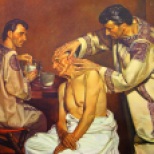
Twinship of the health professions, Pharmacy and Medicine, is nowhere more strikingly portrayed than by Damian, the apothecary, and Cosmas, the physician. Twin brothers of Arabian descent, and devout Christians, they offered the solace of religion as well as the benefit of their knowledge to the sick who visited them. Their twin careers were cut short in the year 303 by martyrdom. For centuries their tomb in the Syrian city of Cyprus was a shrine. Churches were built in their honor in Rome and other cities. After canonization, they became the patron saints of Pharmacy and Medicine, and many miracles were attributed to them.

During the Middle Ages remnants of the Western knowledge of Pharmacy and Medicine were preserved in the monasteries (fifth to twelfth centuries). These scientists are known to have been taught in the cloisters as early as the seventh century. Manuscripts from many islands were translated or copied for monastery libraries. The monks gathered herbs and simples in the field, or raised them in their own herb gardens. These they prepared according to the art of the apothecary for the benefit of the sick and injured. Gardens such as these still may be found in monasteries in many countries.

The Arabs separated the arts of apothecary and physician, establishing in Bagdad late in the eighth century the first privately owned drug stores. They preserved much of the Greco-Roman wisdom, added to it, developing with the aid of their natural resources syrups, confections, conserves, distilled waters and alcoholic liquids. The apothecary is examining logs of sandalwood offered by a traveling merchant, while children indulge their taste for sweets with stalks of sugar cane. When the Moslems swept across Africa, Spain and southern France, they carried with them a new pattern of Pharmacy which western Europe soon assimilated.

Among the brilliant contributors to the sciences of Pharmacy and Medicine during the Arabian era was one genius who seems to stand for his time – the Persian, Ibn Sina (about 980-1037 A.D.), called Avicenna by the Western world. Pharmacist, poet, physician, philosopher and diplomat, Avicenna was an intellectual giant, a favorite of Persian princes and rulers. He wrote in Arabic, often while secluded in the home of an apothecary friend. His pharmaceutical teachings were accepted as authority in the West until the 17th century; and still are dominant influences in the Orient.

In European countries exposed to Arabian influence, public pharmacies began to appear in the 17th century. However, it was not until about 1240 A.D. that, in Sicily and southern Italy, Pharmacy was separated from Medicine. Frederick II of Hohenstaufen, who was Emperor of Germany as well as King of Sicily, was a living link between Oriental and Occidental worlds. At his palace in Palermo, he presented subject Pharmacists with the first European edict completely separating their responsibilities from those of Medicine, and prescribing regulations for their professional practice.

The idea of a pharmacopoeia with official status, to be followed by all apothecaries, originated in Florence. The Nuovo Receptario, originally written in Italian, was published and became the legal standard for the city-state in 1498. It was the result of collaboration of the Guild of Apothecaries and the Medical Society – one of the earliest manifestations of constructive interprofessional relations. The professional groups received official advice and guidance from the powerful Dominican monk, Savonarola, (seated, foreground) who, at the time, was the political leader in Florence.

Trade in drugs and spices was lucrative in the Middle Ages. In the British Isles, it was monopolized by the Guild of Grocers, which had jurisdiction over the apothecaries. After years of effort, the apothecaries found allies among court physicians. King James I, flanked by two “Beefeaters” wore heavily padded attire because of fear of stabbing. Upon persuasion by the philosopher-politician, Francis Bacon, the King granted a charter in 1617 which formed a separate company known as the “Master, Wardens and Society of the Art and Mystery of the Apothecaries of the City of London” over vigorous protests of the grocers. This was the first organization of pharmacists in the Anglo-Saxon world.

Young Parisian Apothecary Louis Hébert answered the call of the New World in 1605, when he helped de Monts and Champlain build New France’s first settlement, the Habitation, at Port Royal (Nova Scotia, Canada). Hébert looked after the health of the pioneers, cultivated native drug plants, and supervised the gardens. At the waterfront, he examined specimens of drug plants offered by Micmac Indians. These included Arum, (Jack-in-the-Pulpit), Eupatorium (Boneset), Verbascum (Mullein), and Hydrastis (Golden Seal). When the Habitation was destroyed by the English in 1613, he returned to his Parisian apothecary shop. The lure of Canada was strong, however, and in 1617, he and the family returned with Champlain to Quebec, where Hébert’s “green thumb” gained him lasting fame as the first successful farmer in what is now Canada.

Many Europeans “of quality and wealth, particularly those who were non-conformists in religion” were attracted to the possibilities of the American Colonies. From Britain came John Winthrop, first Governor of Massachusetts Bay Colony and founder of Boston. Governor Winthrop, unable to induce professionals to the Colony, sought advice from English apothecaries and physicians, and added to his small store of imported drugs those derived from plants native to New England. In his home (about 1640), he made available as best he could the “art and mystery” of the apothecary for his citizens.

Christopher Marshall, an Irish immigrant, established his apothecary shop in Philadelphia in 1729. During 96 years, this pioneer pharmaceutical enterprise became a leading retail store, nucleus of large-scale chemical manufacturing; a “practical” training school for pharmacists; an important supply depot during the Revolution; and finally, it was managed by granddaughter Elizabeth, America’s first woman pharmacist. Christopher earned the title of “The fighting Quaker” during the Revolution; his sons, Charles and Christopher, Jr., (shown as youths with their father, about 1754) earned individual fame and carried on his fine traditions.
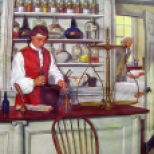
Colonial America’s first hospital (Pennsylvania) was established in Philadelphia in 1751; the first Hospital Pharmacy began operations there in 1752, temporarily set up in the Kinsey house, which served until the first hospital building was completed. The ingenuity of Benjamin Franklin was helpful in both. First Hospital Pharmacist was Jonathan Roberts; but it was his successor, John Morgan, whose practice as a hospital pharmacist (1755-56), and whose impact upon Pharmacy and Medicine influenced changes that were to become of importance to the development of professional pharmacy in North America. First as pharmacist, later as physician, he advocated prescription writing and championed independent practice of two professions.

During his few short years, Carl Wilhelm Scheele gave to the world discoveries that have brought its people incalculable advantages. Yet he never forgot that he was, first of all, a pharmacist. Encouraged by enlightened preceptors, all of his discoveries were made in the Swedish pharmacists in which he worked, as apprentice, as clerk, and finally as owner, in Köping. He began in a corner of the stock room of Unicorn Apothecary in Gothenburg. With rare genius, he made thousands of experiments, discovered oxygen, chlorine, prussic acid, tartaric acid, tungsten, molybdenum, glycerin, nitroglycerin, and countless other organic compounds that enter into today’s daily life, industry, health, and comfort.

The first man to hold the rank of a commissioned pharmaceutical officer in an American army was the Bostonian apothecary, Andrew Craigie. His duties included procurement, storage, manufacture and distribution of the Army’s drug requirements. He also developed an early wholesaling and manufacturing business.

Swedish pharmacist Scheele paved the way for isolating organic plant acids; but it remained for a young German apothecary, Friedrich Wilhelm Adam Sertürner, to give the world opium’s chief narcotic principle, morphine; and to recognize and prove the importance of a new class of organic substances: alkaloids. His first announcements challenged, Sertürner in 1816 conducted a new series of bold, startling experiments in his apothecary shop in Einbeck, including a series of physiologic tests on himself and three young friends. Recognition and fame followed. Relocating in an apothecary shop in Hameln, Sertürner continued organic chemical experimentation and discovery throughout his life.
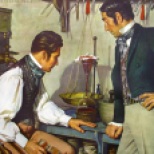
Taking their cue from Sertürner’s alkaloidal experiments, two French pharmacists, Messrs. Pierre-Joseph Pelletier and Joseph-Bienaimé Caventou, isolated emetine from ipecacuanha in 1817; strychnine and brucine from nux vomica in 1818; then, in their laboratory in the back of a Parisian apothecary shop, they tackled the problem that had baffled scientists for decades – wresting the secrets of the Peruvian barks that were so useful against malaria. In 1820 Caventou and Pelletier announced the methods for separation of quinine and cinchonine from the cinchona barks; prepared pure salts, had them tested clinically, and set up manufacturing facilities. Many other discoveries came from their pharmacy-laboratory; high honors were accorded them.

Faced with two major threats; deterioration of the practice of pharmacy, and a discriminatory classification by the University of Pennsylvania medical faculty, the pharmacists of Philadelphia held a tempestuous protest meeting in Carpenters’ Hall, February 23, 1821. At a second meeting, March 13, the pharmacists voted formation of: an association, which became The Philadelphia College of Pharmacy; a school of pharmacy; and a self-policing board. Sixty- eight pharmacists signed the Constitution of the first pharmaceutical association in the United States; American Pharmacy’s first educational institution, bearing the same name, opened November 9.

First U.S. industry in medicinal herbs was carried on by the United Society of Believers in Christ’s Second Appearing, commonly known as the Shakers. Begun about 1820, and commercially important by 1830, the medicinal herb industry grew, hit its peak in the 1860’s, then waned at the close of the century. The Shakers gathered or cultivated some 200 varieties; dried, chopped, and pressed them into “bricks”; wrapped, labeled, and sold them to pharmacists and physicians world-wide. Tons of solid and fluid extracts also were produced. The Shaker label was recognized for reliability and quality for more than a century.

Need for better intercommunication among pharmacists; standards for education and apprenticeship; and quality control of imported drugs, led to calling of a convention of representative pharmacists in the Hall of the Philadelphia College of Pharmacy, October 6 to 8, 1852. Under leadership of its first President, Daniel B. Smith, and first Secretary, William Procter, Jr., the twenty delegates launched The American Pharmaceutical Association; mapped its objectives; and opened membership to “All pharmaceutists and druggists” of good character who subscribed to its Constitution and to its Code of Ethics. The Association continues to serve Pharmacy today.

Over the years, no real discord has existed between representatives of European and American Pharmacy so far as ethical and scientific aims are concerned. But when the groups met for the first time, at the Second International Congress of Pharmacy in Paris, France, August 21 to 24, 1867, there was a great divergence of opinion on the subject of compulsory limitation of pharmacies. William Procter, Jr., leading the delegates of The American Pharmaceutical Association, told the international body that “Public opinion is in America a forceful agent of reform,” and that, in his country, “there is not the slightest obstacle toward a multiplication of drug stores save that a lack of success.” His declaration vividly documented the American Way of Pharmacy.

Rarely has a titular distinction been so deserved. William Procter, Jr., graduated from The Philadelphia College of Pharmacy in 1837; operated a retail pharmacy; served the College as Professor of Pharmacy for 20 years; was a leader in founding The American Pharmaceutical Association; served that organization as its first secretary; later, as its president; served 30 years on the U.S.P. Revision Committee; was for 22 years Editor of the American Journal of Pharmacy. In 1869, though retired, Procter continued to edit the Journal in a small publication office located beside the College’s Tenth Street building. From retirement he returned to P.C.P.’s chair of Pharmacy in1872; literally died “in the harness,” in 1874.

When Dr. Albert B. Prescott launched the pharmacy course at the University of Michigan in 1868, critical attention was aroused because he abandoned the traditional requirement of pregraduation apprenticeship. At the 1871 convention of the American Pharmaceutical Association, he was denied credentials and ostracized. However, the Michigan course pioneered other major changes: laboratory pharmacy, a definite curriculum that included basic sciences, and a program that demanded students’ full-time attention. During the next thirty years, Dr. Prescott had the satisfaction of seeing his once revolutionary innovations generally adopted by pharmaceutical faculties.

The first “United States Pharmacopoeia” (1820) was the work of the medical profession. It was the first book of drug standards from a professional source to have achieved a nation’s acceptance. In 1877, the “U.S.P.” was in danger of dissolution due to the lack of interest of the medical profession. Dr. Edward R. Squibb, manufacturing pharmacist as well as physician, took the problem to The American Pharmaceutical Association convention. Pharmacists formed a “Committee on Revision” chairmanned by hospital pharmacist Charles Rice, assisted by pharmacist-educator Joseph P. Remington, and by Dr. Squibb, their indefatigable collaborator. The “U.S. Pharmacopoeia” surged to new importance.
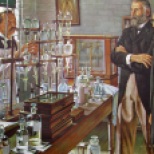
Despite the professional skill and integrity of 19th-century pharmacists, seldom did two preparations of vegetable drugs have the same strength, even though prepared by identical processes. Plant drugs varied widely in active alkaloidal and glucosidal content. The first answer to this problem came when Parke, Davis & Company introduced standardized “Liquor Ergotae Purificatus” in 1879. Dr. Albert Brown Lyons, as the firm’s Chief Chemist, further developed methods of alkaloidal assay. Messrs. Parke and Davis recognized the value of his work, and in 1883, announced a list of twenty standardized “normal liquids.” Parke-Davis also pioneered in developing pharmacologic and physiologic standards for pharmaceuticals.

Scientific explorers opened vast new horizons for Pharmacy late in the 19th century. Sent in 1885 to Peru, Dr. Henry H. Rusby crossed South America amid incredible hardships. He returned with 45,000 botanical specimens, including Cocillana Bark.

The French retail pharmacist, Stanislas Limousin, introduced many devices to Pharmacy and Medicine. His greatest contributions were invention of glass ampoules, the medicine dropper, and apparatus for inhalation of oxygen.
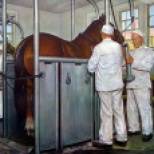
Biological products (made from micro-organisms) got their discovery of diphtheria antitoxin by the German, Behring, in 1894. Pharmaceutical manufacturers since have constantly improved serums, antitoxins and vaccines, which have saved countless lives.

One of the successful researchers in the development of new chemical compounds specifically created to fight disease-causing organisms in the body was the French pharmacist, Ernest Francois Auguste Fourneau (1872-1949), who for 30 years headed chemical laboratories in the world-renowned Institut Pasteur, in Paris. His early work with bismuth and arsenic compounds advanced the treatment of syphilis. He broke the German secret of a specific for sleeping sickness; paved the way for the life-saving sulfonamide compounds; and from his laboratories came the first group of chemicals having recognized antihistaminic properties. His work led other investigators to broad fields of chemotherapeutic research.

Research in some form has gone hand in hand with the development of Pharmacy through the ages. However, it was the chemical synthesis of antipyrine in 1883 that gave impetus and inspiration for intensive search for therapeutically useful compounds. Begun by the Germans, who dominate the field until World War I, the lead in pharmaceutical research passed thereafter to the United States. Research in Pharmacy came into its own in the late 1930’s and early 1940’s; has grown steadily since, supported by pharmaceutical manufactures, universities, and government. Today it used techniques and trained personnel from every branch of science in the unending search for new life-saving and life-giving drug products.

Pharmaceutical manufacturing as an industry apart from retail Pharmacy had its beginnings about 1600; really got under way in the middle 1700’s. It developed first in Germany, then in England and in France. In America, it was the child of wars – born in the Revolution; grew rapidly during and following the Civil War; became independent of Europe during World War I; came of age during and following World War II. Utilizing latest technical advances from every branch of science, manufacturing Pharmacy economically develops and produces the latest and greatest in drugs in immense quantities, so that everywhere physicians may prescribe them and pharmacists dispense them for the benefit of all mankind.

Antibiotics are not new. Their actions probably were first observed by Pasteur in 1877. However, the second quarter of the 20th century marked the flowering of the antibiotic era – a new and dramatic departure in the production of disease-fighting drugs. Fleming’s discovery of penicillin in 1929 went undeveloped and Florey and Chain studied it in 1940. Under pressure of World War II, the pharmaceutical manufacturers rapidly adapted mass production methods to penicillin; have reduced costs to 1/1000th the original. Antibiotic discoveries came rapidly in the ’40’s. Intensive research continues to find antibiotics that will conquer more of men’s microbial enemies.

Pharmacy, with its heritage of 50 centuries of service to mankind, has come to be recognized as of the great professions. Like Medicine, it has come through many revolutions, has learned many things, has had to discard many of its older ways. Pharmacists are among the community’s finest educated people. When today’s retail pharmacist fills a prescription written by a physician, he provides a professional service incorporating the benefits of the work of pharmacists in all branches of the profession – education, research, development, standards, production, and distribution. Pharmacy’s professional stature will continue to grow in the future as this great heritage and tradition of service is passed on from preceptor to apprentice, from teacher to student, from father to son.



































